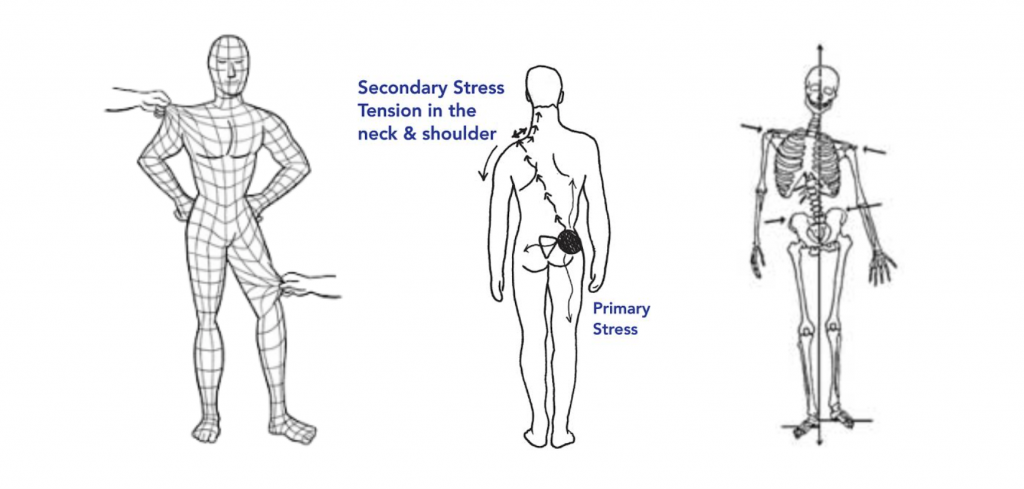One of the problems inherent in traditional treatment is the reliance on the outdated kinesiology framework that views that body as a separate muscle groups that act in isolation.
While local symptomatic treatment should be a part of the overall process – someone with recurring plantar fasciitis – does not just have a “foot” problem. If treatment only involves soft-tissue work at the foot and lower leg, icing, and rest – the symptoms are probably going to return.
This is especially important for runners that need to be able to appropriately distribute loads throughout their body as they run. Studies have demonstrated that runners with recurring ankle sprains consistently have muscle imbalances in their hip and weakened gluteal muscles.
If there is tightness and limited range of motion elsewhere in the body and the glutes are not properly stabilizing the pelvis – the mechanics of the foot will not be changed by only applying treatment to the foot and lower leg.

Structural Integration is a soft-tissue treatment approach that examines the relationships between muscle groups, and how the pelvis and spine are aligned in relation to the feet below and the ribcage above. This provides a framework for more effective treatment because the whole body is examined – not just a particular joint or muscle group.
What is Structural Integration?
Structural Integration is a type of bodywork that focuses on the connective tissue, or fascia, of the body. Fascia surrounds muscles, groups of muscles, blood vessels, organs, and nerves, binding some structures together while permitting others to slide smoothly over each other.
Fascia is designed to be elastic and move freely with muscles and bones. Injury, stress, work-related repetitive movements and the effects of aging can cause fascia to lose its elasticity and become shorter, tighter, and more dense. Tightened fascia pulls our muscles and skeleton out of proper alignment and posture, which can cause pain, discomfort, and fatigue.
Structural Integration works to lengthen, stretch, and soften this tissue to restore postural balance, ease of movement, and a feeling of being more at home in your own body. It is practiced in an organized series of sessions or individual sessions within a framework that is designed to restore postural balance by aligning and integrating the body in gravity. Structural Integration is based on the work of Dr. Ida P. Rolf. It is practiced by persons trained in Structural Integration.
Benefits of Structural Integration
- Improved posture and alignment
- Spinal decompression
- Elimination of chronic pain
- Better breathing and diaphragm function
- Improved connective tissue health
- Effective scoliosis treatment
- Greater ease of movement
- Enhanced body awareness

One important principle of Structural Integration is that the body is significantly affected by the powerful force of gravity. In a misaligned state, the body’s valuable resources are used inefficiently, laboring to keep a person upright in the field of gravity. In addition, the stresses of daily life, physical injuries, unhealthy movement patterns and attitudes are things that can take a toll on one’s physical structure. Over time, the body will shorten and tighten to accommodate stresses, creating stiffness, pain, fatigue and lack of well-being.
Instead of a treatment framework that focuses primarily on the spine (chiropractic), joints (physical therapy), or muscles (massage) – Structural Integration targets the connective tissue which impacts all of the above structures – while factoring in their relationship to one another.
Structural Integration differs from traditional myofascial release techniques in that it is guided by a framework of balance throughout the entire body. The soft-tissue techniques are secondary to the desired outcome that guides their application.

This treatment strategy is guided by the concept of, “Tensegrity” which looks at the three-dimensional pull of muscles (and their surrounding connective tissue) which balance the compressional forces throughout the entire body.
Tensegriteach from AnatomyTrains on Vimeo.
While I integrate this treatment modality into all of my sessions – I do offer a Structural Integration treatment package of twelve sessions as a stand-alone therapy.
Fascial Stretch Therapy is a great follow-up treatment to Structural Integration that maximizes joint range of motion, develops ongoing flexibility, and functions as an effective running maintenance/recovery therapy for long distance runners after they have rebalanced their entire body against gravity with Structural Integration.